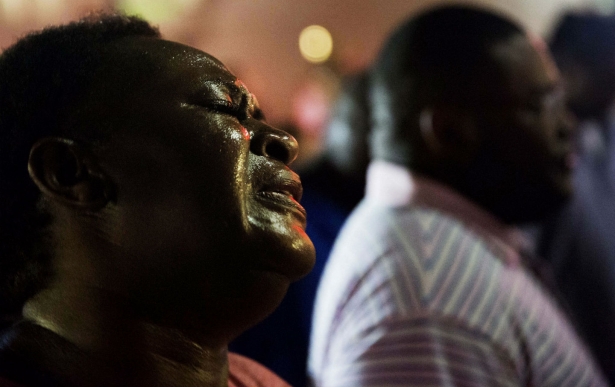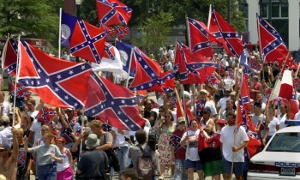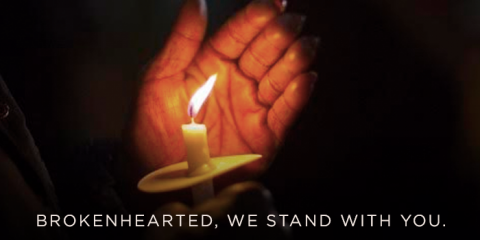- The Charleston Massacre and the Cunning of White Supremacy - Greg Grandin (The Nation)
- We Must Respond to the Right-wing Attempt to Reframe the Charleston Massacre - Bill Fletcher, Jr.
- Confederate Flag Raises Renewed Ire Following Charleston Church Killings - Tom McCarthy (The Guardian)
The Charleston Massacre and the Cunning of White Supremacy
By Greg Grandin
June 18, 2015
TheNation.com Blog

A prayer circle gathers early Thursday, June 18, 2015, down the street from Emanuel AME Church following Wednesday night's shooting.
credit - AP Photo/David Goldman // The Nation
According to Matt Ford at The Atlantic, the Charleston, South Carolina, church where a white gunman murdered nine people was
The oldest black church south of Baltimore, and one of the most storied black congregations in the United States, Emanuel African Methodist Episcopal Church's history is deeply intertwined with the history of African American life in Charleston. Among the congregation's founders was Denmark Vesey, a former slave who was executed in 1822 for attempting to organize a massive slave revolt in antebellum South Carolina. White South Carolinians burned the church to the ground in response to the thwarted uprising; along with other black churches, it was shuttered by the city in 1834. The church reorganized in 1865, and soon acquired a new building designed by Robert Vesey, Denmark's son; the current building was constructed in 1891. It has continued to play a leading role in the struggle for civil rights.
Denmark Vesey is one of the most prominent names in America's long history of racial terror. And the killer didn't choose just Vesey's church but his anniversary. Based on fragmentary evidence, white Charlestonians in 1822 came to believe that Vesey's revolt "would begin at the stroke of midnight as Sunday, June 16, turned to Monday, June 17." And they identified Vesey's church as the center of the conspiracy.
White militia began to arrest both freemen and slaves, 10 that weekend, and many more in the days that followed. Vesey, a freeman, was captured on June 22. It's not just the executors of the "war on terror" who have used euphemisms to describe torture. A Charleston official referred to the interrogations the captured men were subject to like this: "No means which experience or ingenuity could devise were left unessayed to eviscerate the plot."
Then, after a quick trial and guilty verdict, Vesey and five others were hung on July 2. More arrests were made, and more executions followed, 35 in total, often in front of immense crowds.
Here's the historian Ira Berlin, summing up what is known of Vesey's life:
It is a story well worth the telling. One of millions of young Africans sold into the Atlantic slave marts in the 18th century, the young Telemaque-later transmuted into Denmark-was plucked from a cargo of some 400 slaves by Captain Vesey, who was taken by his "beauty, alertness and intelligence." Vesey assigned the lad to his cabin, taught him to read and write, and allowed him to learn a trade-and much else.. The Veseys, both the captain and his slave, eventually alighted in the city of Charleston, mainland North America's largest slave port. There, Captain Vesey retired to a comfortable respectability, supported in part by the earnings of his slave, who was permitted to hire himself out on his own.. While Denmark Vesey crossed the line from slavery to freedom, he did not.affiliate with Charleston's growing community of free people of color. These artisans and tradesmen, with light skins that betrayed their mixed racial origins, aspired to the privileges of the master class, whose deportment, speech and values-including slave ownership-they emulated. Rather than being satisfied with a pale imitation of freedom, Vesey became increasingly discontented. In the back alley groggeries and weekly Bible classes, he denounced slavery as criminal usurpation, citing the Scriptures, the Declaration of Independence and even Congressional debates. He sneered at those who accepted bondage and deferred to whites, declaring that they deserved to be slaves. The angry old man awed even those he did not intimidate. Vesey believed slavery would only end with fire, and understood that a successful insurrection rested upon uniting the fragmented black population. While he may have dismissed the assimilationist-minded free people of color, he believed the other elements of the black community could be brought together. To those taken with Christianity, he quoted the Bible. To those mindful of power, he spoke of armies of Haitian soldiers in waiting. To those fearful of the spirit world, he enlisted one Jack Pritchard-universally known as Gullah Jack-a wizened, bewhiskered conjurer whose knowledge of African religious practices made him a welcome figure on the plantations that surrounded Charleston. And while he drew followers from the slave quarter and the artisans' shops, he also enlisted from the master's household, recruiting even the personal servant of South Carolina's governor. Vesey coaxed and cajoled, implored and exhorted, flattered and bullied until his scheme was in place.
Berlin writes that "while slaveholders sent Denmark Vesey to the gallows and committed him to an unmarked grave, they failed to consign him to historical oblivion.. Former slaves preserved his memory, even as former slaveholders denied it. Today it seems clear that Denmark Vesey will not remain buried much longer."
Maybe others remembered him as well, though it might just be a coincidence that "the clean-shaven white man about 21 years old with sandy blond hair and wearing a gray sweatshirt, bluejeans and Timberland boots" chose the anniversary of Vesey's preempted revolt to massacre nine members of the congregation Vesey founded.
Or maybe history, along with white supremacy, is just cunning that way.
[Greg Grandin is the author of a number of prize-winning books, including most recently "The Empire of Necessity: Slavery, Freedom, and Deception in the New World," which won the Bancroft Prize in American History. "Fordlandia: The Rise and Fall of Henry Ford's Forgotten Jungle City" was a finalist for the Pulitzer Prize in History, as well as for the National Book Award. Grandin's other books include "Empire's Workshop, The Last Colonial Massacre, The Blood of Guatemala," and the co-edited (with Gil Joseph) anthology, "A Century of Revolution: Insurgent and Counterinsurgent Violence during Latin America's Long Cold War." A professor of history at New York University and a member of the American Academy of Arts and Sciences, Grandin writes on American Exceptionalism, US foreign policy, Latin America, genocide, and human rights. He has published in The New York Times, Harper's, The London Review of Books, The Nation, The Boston Review, The Los Angeles Times, and The American Historical Review.]
Copyright c 2015 The Nation. Reprinted with permission. May not be reprinted without permission. Distributed by Agence Global.
Please support our journalism. Get a digital subscription to The Nation for just $9.50!
We Must Respond to the Right-wing Attempt to Reframe the Charleston Massacre
By Bill Fletcher, Jr.
June 18, 2015
BillFletcherJr.com
I never cease to be amazed by the speed and the ability of the political Right to distort the truth.
The attempt by the political Right to reconstruct the Charleston massacre as an attack on Christianity defies belief. Yet it is something that we cannot simply sit back and allow to play out. This is a moment when we must connect the Charleston massacre with the lynchings that are regularly taking place against people of color generally and African Americans in particular. The Charleston massacre, allegedly carried out by someone comfortable wearing the flags of apartheid South Africa and white supremacist Rhodesia, is a continuation in the line of assaults on Black America.
The fact of the matter is that there is no basis to believe that this white man walking into a Black church and murdering Black people had anything to do with any antipathy to Christianity, It has to do with an antipathy to Black people. It also has the markings of someone who probably wished to ignite a race war.
The political Right will do whatever it can to move the eyes of reasonable people away from analyzing race. When African Americans, Native Americans or Latinos are attacked by the police, the Right-wing moves quickly to question the motives, not of the police but of the victims. When acts of violence after acts of violence against African Americans are held up for the entire world to see, the political Right does its best to question each incident and try to demonstrate how any ambiguity in one case should somehow compromise the integrity of any suggestion of a demonstrable pattern.
The fact that the Charleston massacre took place in a church should, however, demonstrate one fact about religion. White supremacists are not restrained or constrained by the fact that the targets of their hatred may be people of faith. As far as the white supremacists are concerned, those murdered in Charleston are not worshiping the same Creator of All Things as are the white supremacists.
One thing that can be done immediately is to contact right-wing media outlets and politicians and convey, in no uncertain terms, that we do not appreciate their commentary on the Charleston massacre. The `analyses' offered by these right-wing pundits remind me of something that my father used to say: "It is better to keep one's mouth quiet and to be thought of as a fool than to open one's mouth and prove it." Oh, how I wish that Fox News would appreciate that point.
[Bill Fletcher Jr has been an activist since his teen years. Upon graduating from college he went to work as a welder in a shipyard, thereby entering the labor movement. Over the years he has been active in workplace and community struggles as well as electoral campaigns. He has worked for several labor unions in addition to serving as a senior staffperson in the national AFL-CIO.
Fletcher is the former president of TransAfrica Forum; a Senior Scholar with the Institute for Policy Studies; an editorial board member of BlackCommentator.com; and in the leadership of several other projects. Fletcher is the co-author (with Peter Agard) of "The Indispensable Ally: Black Workers and the Formation of the Congress of Industrial Organizations, 1934-1941"; the co-author (with Dr. Fernando Gapasin) of "Solidarity Divided: The crisis in organized labor and a new path toward social justice"; and the author of "`They're Bankrupting Us' - And Twenty other myths about unions." Fletcher is a syndicated columnist and a regular media commentator on television, radio and the Web.]
Confederate Flag Raises Renewed Ire Following Charleston Church Killings
Protesters call for symbol of racial division to be removed from the grounds of the South Carolina state building in Columbia
By Tom McCarthy
June 18, 2015
The Guardian (UK)

Demonstrators carry Confederate flags during a July 2000 march to protest the removal of the flag from the South Carolina statehouse in Columbia.
credit - Photograph: Eric Draper/Associated Press // The Guardian
Fifteen years ago, the Confederate flag was removed from the top of the state house building in Columbia, South Carolina. It was moved all of 200 feet, to be planted next to a Confederate memorial inside capitol grounds. Now there is a call for the flag to be moved again - to somewhere no one can see it.
A day after nine African-American men and women were gunned down inside a historic black church in Charleston, allegedly by a white gunman with racist views, mourners and protesters renewed a call that never quite seems to go away in South Carolina: why is the people's house draped with a symbol of racial division - or regional heritage, as its proponents hold?
Some in South Carolina contacted for this story said the blood of the victims is too fresh to resurrect the flag debate. Or that people rush to fight about the flag because they want to change the subject, to turn away from the latest proof that an old hatred is alive and well.
"We have been able to change a lot of racism," state senator John W Matthews, 75, a Democrat who has served two decades in the legislature, told the Guardian. "What I call it, racism that you can see. We've changed public accommodation, open houses, access to restaurants. And so those things that are visible, we have changed substantially. But racism of the heart is the most difficult to change. And that has not changed fully."
Before the killings on Wednesday night, the debate over the Confederate flag in South Carolina had not been as vital as it once was. Fifteen years ago, the flag was the subject of a gritty partisan struggle in the state house and an economic boycott by the NAACP. The fight even broke into the 2000 presidential campaign, with Republican candidate John McCain defending the flag's placement, only to admit, after he had lost, that he had only taken his stance to win the state's primary.
The real friction was inside the South Carolina legislature, however, where a core group of Republican senators squared off to oppose African-American leaders such as state senators Kay Patterson and Matthews, who wanted the flag taken down. Flag opponents saw a special opportunity in support from of the freshly installed Democratic governor, Jim Hodges.
The two sides eventually cut a deal to move the flag to the Confederate monument. Hodges signed the law to move the flag in May 2000 - the same month that he signed a law making South Carolina the last state to recognise Martin Luther King Jr day as a paid holiday. A rectangular version of the flag that had flown atop the capitol was replaced with a more historically accurate, square-shaped flag with a border.
Matthews said the goal in 1999 was to remove not only the Confederate flag on top of the capitol building, but also the multiple flags inside it. "The removal of the flags, you've got to understand, the time in which the debate was taking place, we were still talking about the values of the old South and not necessarily the new South," Matthews said in an phone interview from his home in Columbia. "And those values of the old South, the Caucasian community - not necessarily to all but to a lot of them - they thought [the flag] was important. But to African-Americans, we saw it as suppression.
"There were flags in the chambers, and each one was hanging in the state house over the desks. And when you said the pledge of allegiance in the morning, you had to look at those flags. There were flags in the rotunda. There was a flag on top of the state house, which implies sovereignty."
The removal of the flag to the Confederate monument was the last of multiple compromises the two sides had considered, Matthews said. "There were several proposals on the table. It finally wound up, the compromise was, to put it out there by the Confederate monument. Everybody didn't quite agree to that. That was the compromise. That took out about five flags. One atop the statehouse, and about three or four out of the statehouse. First we had a compromise to put it in the museum, which is where we thought it should be. That was a very close vote."
Matthews recalled serving in the legislature with Clementa Pinckney, the reverend who was among those shot dead inside Emanuel AME church Wednesday. Pinckney had been a state senator since 2001. "His passion was to serve people and to change this state," Matthews said. "Senator Pinckney being elected to the senate will tell you how far we've come. How he died will tell you how far we have to go."Charleston


Spread the word